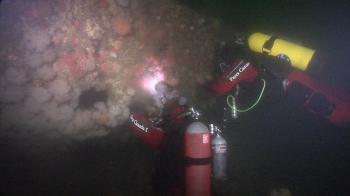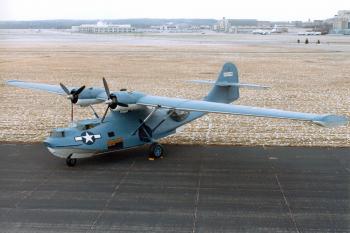“We were looking for shipwreck stories and the people told us about a ship that went down. This was very important local history. There had been an American base there from 1942 to 1949,” said Marc-André Bernier, Parks Canada’s chief of underwater archaeology.
Mr. Bernier directed the dives that involved six of the agency’s seven underwater archaeologists.
“We especially looked for the plane and found it. We used historical data but also the testimonies of the witnesses,” he said.
Although none of the rescuers are still alive, about 10 people who witnessed the accident on November 2, 1942, at about 6 p.m. are still living. They ranged between 11 and 25 years of age at the time.
The U.S. built a series of airfields in eastern Canada in 1941 and 1942 to ferry aircraft to Allied air forces in Europe.
The Longue-Pointe-de-Mingan airport was part of this strategic air corridor, serviced by the Catalina until it foundered following two failed take-off attempts amid two-metre-high waves.
A heavy wave hit the plane and opened a large leak in the nose wheel well. Water quickly filled the cockpit as the front of the plane sank.
Four crew members escaped through the side windows and were rescued by local villagers in small rowboats, but there was no sign of the other five crewmen.
Everyone in the village gathered on the beach the day the accident occurred, and the story has been passed down through the generations.
The witnesses have a clear memory of the event and the plane, said Mr. Bernier, adding that the locals are “very, very happy and touched” that the plane was found.
“The presence of the American soldiers in the area was a very positive thing for them. . . . They have very good memories of that, so for them, to have that plane found, it was very important.”
Repatriation
In the spring Mr. Bernier’s team found the Catalina using side-scan sonar, a remote-sensing technique capable of producing an image of the sea bottom via sound signals sent down to the bottom and the echoes received back.
The technique uses a piece of equipment, called a “fish,” that continuously transmits sound pulses as it is towed behind a boat navigating across a designated area.
After pulling the fish for many kilometres, the landscape of the bottom and details of the plane “were clearly visible” on the sonogram, said Mr. Bernier.
It was so precise that the archaeologists could see the shape of the hull and determine that the wings were buried. The measurements and details convinced them it was the plane they were looking for.
The archaeologists next took videos of the site using a remotely operated vehicle (ROV) controlled from the surface.
The ROV videos allowed them to plan their own dives to ensure they would be safe and focused, since the depth of the site limited the divers’ exploration time to less than 10 minutes.
The dives provided further confirmation that the aircraft was the Catalina. For example, the divers found that the nose wheel doors were completely torn off, which corresponded to the damage that the wave had made in the accident.
Looking in the openings of the sunken craft, the archaeologists saw a great deal of sand cover. They believe this may have preserved the plane’s contents, which could include human remains and possibly personal possessions.
The next step is for the U.S. to assess the findings and decide on subsequent action, with the objective of repatriating the soldiers.
The archaeologists hope to be able to do the excavation under water rather than raising the plane to the surface, “but we’re looking at all possibilities,” Mr. Bernier said.








